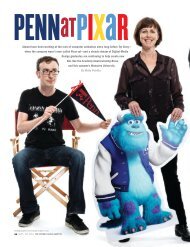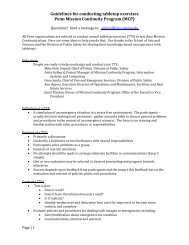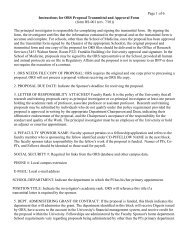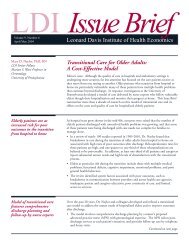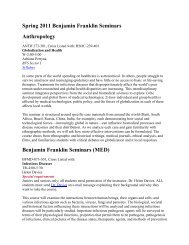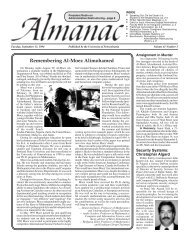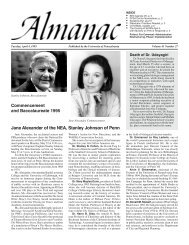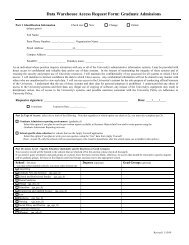Download this article (PDF) - University of Pennsylvania
Download this article (PDF) - University of Pennsylvania
Download this article (PDF) - University of Pennsylvania
You also want an ePaper? Increase the reach of your titles
YUMPU automatically turns print PDFs into web optimized ePapers that Google loves.
He found himself surrounded by mummies, maybe half a dozen At that point, though, he was still a “Chinese language and<br />
in all. Not the usual sort <strong>of</strong> mummies, wrapped in rotting gauze literature guy with a lot <strong>of</strong> experience about central Asia,”<br />
or looking like something out <strong>of</strong> a zombie movie. These were albeit one who was “curious about everything.” And the discovery<br />
<strong>of</strong> Ötzi “galvanized” him.<br />
astonishingly well-preserved people <strong>of</strong> decidedly un-Chinese<br />
appearance, dressed in their everyday clothes. Though their “What really goaded me to go to the mummies was that [Ötzi]<br />
remains were identified as thousands <strong>of</strong> years old, they looked as had an army <strong>of</strong> researchers working on him,” he adds. “It wasn’t<br />
though they were sleeping and could wake up at any moment. fair. Those Xinjiang mummies—nobody was working on them;<br />
Mair was stunned—and skeptical.<br />
nobody even knew about them. I said to myself, ‘They’re every<br />
“I looked at the mummies and said, ‘Oh, <strong>this</strong> is a hoax,’” he bit as important as he is. Maybe even more important.’ They’re<br />
says. “They looked like something out <strong>of</strong> Madame Tussauds in the center <strong>of</strong> Asia, at the crossroads <strong>of</strong> Asia. Before that it<br />
Wax Museum—they’re too well preserved. Then all the clothing<br />
was so immaculate, so pristine, and the colors were very den there were all these Caucasian people with all <strong>this</strong> advanced<br />
was just a big lacuna in that part <strong>of</strong> the world; then all <strong>of</strong> a sud-<br />
vivid and bright. And perfectly intact! Nothing destroyed.” technology, right up there against China—very early.”<br />
Mair had examined enough ancient manuscripts from the He pauses for just a moment, and adds: “That very afternoon,<br />
area to know that the salty sands and freeze-drying climate <strong>of</strong> I became an archaeologist.”<br />
the Tarim Basin, where the mummies were found, are highly<br />
conducive to preservation. (“The most linguistically diverse Richard Hodges, the Williams Director <strong>of</strong> the Penn<br />
library in the ancient world has survived in the drying sands<br />
Museum and an eminent archaeologist in his own<br />
<strong>of</strong> the Tarim Basin,” he and co-author James Mallory wrote in<br />
right, is talking with easy precision about the “two<br />
their 2000 book, The Tarim Mummies: Ancient China and the<br />
great issues” in world archaeology today.<br />
Mystery <strong>of</strong> the Earliest Peoples from the West.) But their One, he explains, is “that whole issue <strong>of</strong> man coming out <strong>of</strong><br />
remarkable condition wasn’t the only<br />
Africa, particularly sub-Sahara Africa,<br />
puzzling thing about these mummies.<br />
and crossing into the Middle East, then<br />
“They had all <strong>this</strong> advanced technology:<br />
bronze, and high-level textile tech-<br />
That’s a sort <strong>of</strong> prelude to the second<br />
moving eastwards and northwards.”<br />
nology, different kinds <strong>of</strong> tools—they<br />
issue—which, he says, involves “what<br />
had wheels, for example. Everything<br />
was happening between Asia and<br />
made me think <strong>this</strong> was too advanced<br />
Europe and the Middle East and <strong>this</strong><br />
for <strong>this</strong> time in <strong>this</strong> place.”<br />
crucible <strong>of</strong> the Old World” over the past<br />
Even more brain-scrambling was the<br />
three millennia.<br />
fact that they looked so … European. Their<br />
“The Tarim Basin is smack-bang in<br />
height (tall). Hair (blond, reddish-brown,<br />
the middle <strong>of</strong> <strong>this</strong> crucible,” Hodges<br />
fine-textured). Facial structure. Clothing.<br />
says forcefully. “And the archaeology<br />
Mair was especially drawn to one<br />
that’s come from it, the new finds that<br />
mummy whose remains were identified<br />
have been made in that region, are<br />
as dating back to 1000 BCE. Chärchän<br />
extraordinary.” The result is “a remarkable<br />
chance to get to grips with those<br />
Man, excavated from Chärchän (Qiemo The salty sands and freeze-drying climate <strong>of</strong><br />
in Modern Standard Mandarin), was sixfoot-seven,<br />
with longish blond-brown found, are highly conducive to preservation. ested archaeologists for centuries on a<br />
the Tarim Basin, where the mummies were extraordinary issues that have inter-<br />
hair and beard, and his clothing included<br />
a reddish-purple woolen shirt trimmed with red piping. because they were myopic,” Hodges adds. “And now <strong>this</strong> big,<br />
big scale”—until they “lost interest<br />
Mair promptly dubbed him Ur-David, on account <strong>of</strong> the grand narrative is back for us.”<br />
remarkable resemblance to his very-much-alive brother Dave. The narrative takes physical form in Secrets <strong>of</strong> the Silk<br />
But beyond that eerie resemblance bubbled a serious question:<br />
What in God’s name was a tall, fair-haired man with that that opens at the Penn Museum February 5 and runs through<br />
Road, an exhibition <strong>of</strong> Tarim Basin mummies and artifacts<br />
kind <strong>of</strong> clothing doing in east-central Asia 3,000 years ago? June 5. The exhibition is “fantastic,” says Hodges, “because<br />
Mair sent his tour members back to the hotel, and spent the it really demands that you have the kind <strong>of</strong> imagination to<br />
next few hours in that dark room, meditating on the implications<br />
<strong>of</strong> its inhabitants. He filed the mental images away and we are and where we came from.”<br />
look across huge distances and ask big questions about who<br />
went back to studying manuscripts.<br />
For Mair, the fact that an exhibition <strong>of</strong> Tarim mummies and<br />
Three years later, he found himself reading a story in The artifacts is coming to the Penn Museum at all borders on the<br />
New York Times about a frozen 5,300-year-old body that had “miraculous.” Not just because it’s a blockbuster show with dazzling<br />
objects and a raft <strong>of</strong> innovative special programs that rep-<br />
just been discovered in the Ötztaler Alps on the border between<br />
Austria and Italy. Ötzi the Iceman, as he became known, “died resents a quantum leap forward for the Museum, though it is and<br />
at the top <strong>of</strong> the Similaun Glacier, right near where my father it does. (See sidebar on p. 44.) It’s also that he had long since given<br />
pastured his animals when he was a boy,” says Mair. The weird up hope that any <strong>of</strong> those mummies and artifacts would ever<br />
convergence <strong>of</strong> time and place and pr<strong>of</strong>essional interests make it out <strong>of</strong> China, let alone to West Philadelphia.<br />
prompts a grin. “I was born to be a mummy guy,” he says.<br />
Fifteen years ago, he was turned down for a similar show, on<br />
42 JAN | FEB 2011 THE PENNSYLVANIA GAZETTE<br />
PENN MUSEUM



